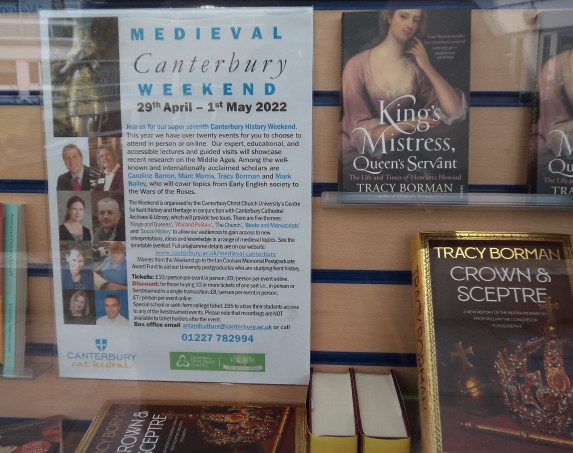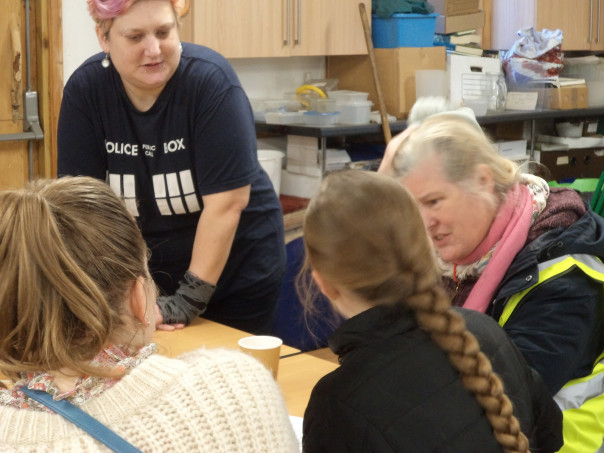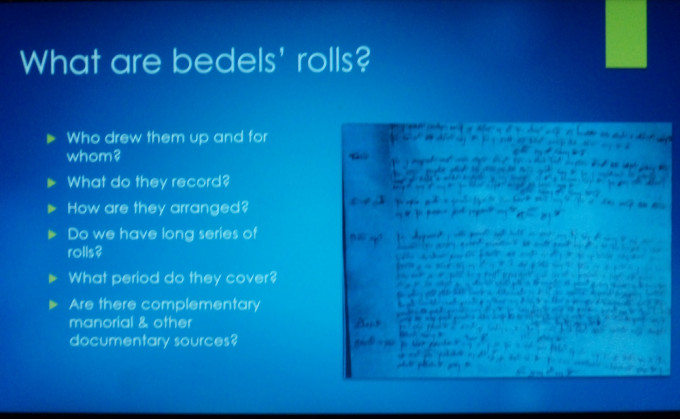There is a great deal to cover concerning activities linked to CKHH this week. Nevertheless, I thought I would start with the Medieval Canterbury Weekend because Craig in the CCCU Bookshop has very kindly displayed a poster for the Weekend in the bookshop window with Dr Tracy Borman’s new book and some of her previous works. Please note the Bookshop will be open during the Weekend and tickets for this exciting occasion are available at https://www.canterbury.ac.uk/medieval-canterbury – do come and join.

Turning first to Dr Claire Bartram’s new Instagram account which was launched only on Tuesday. Please do check it out and she would be delighted if you would like to follow her to find out about all the exciting happenings in relation to the Centre, including her IHR Centenary Project on Dover: https://www.instagram.com/ckhhkenthistoryheritage/ as well as Dr Diane Heath’s ‘NHLF-funded ‘Medieval Animals Heritage’ project.
As part of this latter project, Diane and Penny Bernard have had two events this week. At the first on Monday, they were aided by two third-year undergraduate volunteers, and other helpers for the project’s outing to Wildwood. Being half term, the project welcomed several SEND families to explore the wonderful wildlife there under the guidance of Langan Turner (Education Manager) who took us on a fascinating walk around parts of the animal park. Among the animals we saw were eagle owls, brown and black rats, several lynxes, including two youngsters, and those distinctive birds from the crow family, the chough with its red beak and legs. These birds are part of a breeding and reintroduction programme that will see them reintroduced to the cliffs at Dover – an exciting prospect!
After our walk we returned to Wildwood’s Education Centre for hot chocolate and biscuits, and then a ‘Medieval Animal Heritage East Kent Quiz’. This had been devised by Penny and comprised 4 rounds included identifying animal images and ‘true or false!’ regarding statements about specific animals. For example, the choice for the fox was a) ‘They are untrustworthy and will trick you into their jaws, just like the Devil’ or b) ‘Foxes are wise and charming, and people like them make for good friends’. As one of the easiest questions, it will not surprise you that the answer is (a), but some questions were more challenging. However, the families were more than capable, and all scored highly, as well as having a great time, as evidenced by the feedback afterwards.

The second event was the launch on Tuesday of the competition to design the Eco-Heritage Learning Space for the Franciscan Gardens. The competition is for undergraduate students from the School of Architecture at the University of Kent and following Diane’s presentation on the project brief as designed by Penny, 60 students have signed up to submit their proposals. Again, this is a very exciting development and Diane and Penny hope this will be the first of many such Learning Spaces across the country in the future. The ‘Medieval Animals Heritage’ team is working with the Trustees of Eastbridge Hospital on this inaugural installation and among the guests at the reception held at the School of Architecture were Louise Knight and Josh Rhodes from Eastbridge Hospital which these days cares for the Franciscan Gardens. It is hoped that the Learning Centre will be up at running by July this year, a welcoming, environmentally friendly place for SEND families to use as a creative space for art, craft and other activities.
Turning to the Lossenham Project, another initiative in which the CKHH is heavily engaged, at least on the History side, on Tuesday evening I led an online workshop on exploring bedels’ rolls to see how useful they can be concerning investigating farming practices and land use strategies in the Middle Ages. Hardly surprisingly, the best and most abundant series coincide with the period of direct farming by the great landlords which means such rolls are especially valuable for these activities during the later 13th and across the 14th centuries, in the 15th century the demesne lands of such manors were generally farmed out to tenant farmer(s) for a set rent. As I pointed out, in terms of surviving rolls series, the best come from monastic houses because being corporate bodies they didn’t die, or not frequently before the Dissolution, which means they were far less vulnerable to asset stripping by those holding them during the minority of an heir, for example. Even better are those rolls produced by a monastic house which were refounded as a Dean & Chapter – witness the abundant records for Christ Church Priory compared to its Benedictine neighbour St Augustine’s Abbey.

Thus, having talked briefly about what bedels’ rolls are, how they are arranged and their uses for the medieval historian, I provided a snapshot using a single roll from the manor of Ebony because that was the closest manor to Newenden and being at the Isle of Oxney should offer insights into farming and land use within the Rother Levels during the High Middle Ages. I had decided to use the roll for 1299/1300 because that was neither during the ‘Great Storms’ nor the ‘Great Famine’ and hopefully would provide an idea about a ‘normal’ year. Just to provide a few indicators of what this roll shows, the first point is that it fits within Professor Bruce Campbell’s assessment of Kent that mixed farming with cattle, although other livestock were also present, was the predominant strategy of these great landlords. Going beyond this designation, the arable lands were used that year at Ebony to grow wheat primarily as a cash crop for market, rye – all the previous year’s harvest used as seed, and oats. In many ways the oats are by far and away the most interesting because they were winter and spring-sown at a ratio of 1: 4 and in this year 117 acres were sown in spring. No legumes are mentioned for this year but at other times beans and to a far lesser extent vetch were grown for fodder/green manure. Although some oats were sold, the vast majority of the previous year’s harvest was used for seed (Ebony as on other Christ Church manors used at least double the normal seed rate compared to much of lowland England at this time) and as liveries for horses (harrowing and ploughing) and for the workers – specialists and the farm servants, the latter apparently living largely on potage and ale.
Turning to the livestock, the demesne supported a mixed dairy of 30 cows and 142 ewes, which if you can apply modern stocking rates would, if I remember correctly, suggest that the cows and sheep had about an equal acreage for the herd/flock. Dairying not surprisingly took place in summer as well as extending into early autumn, the dairymaid getting her oat allowance from St George’s day until Michaelmas, this later milk, butter and cheese perhaps in response to the autumn flush of grass. Some of this cheese, as at Christ Church’s manor of Agney on the Romney Marshes, was destined for consumption in Canterbury being sent to the priory’s cellarer. For the cows, replacements this year came in the form of one of the manor’s own heifers, but the serjeant was also prepared to buy an in-calf cow, while for the ewes it seems replacements came from Ebony’s own lambs that had been reared at Appledore, returning to Ebony before tupping.

The pig herd was much smaller, comprising a boar and 3 sows and even though 30 piglets were born that year of the older animals, losses were high at 50 dying with only 32 sold for consumption, two thirds going to the cellarer. Poultry in the form of peacocks and hens similarly ended up on the table at Canterbury, presumably to the delight of the priory’s special guests, whereas geese, capons, and hens were sold, perhaps locally. Even though the serjeant experienced some problems during the year and had to spend over £5 on sea walls with a further 11s on ditching and almost 30s on the demesne buildings, receipts exceeded expenses by about £7, and the detailed accounts offer ideas about just how he had managed to achieve this successful outcome.
This exploration provoked a considerable discussion about these farming practices, as well as whether there is evidence of the use of timber from the manor and what sort of material was being used to roof the two barns and small stable. Other topics included whether such records have been digitised, to which the answer is no except for a very few rolls, and is it feasible to use this series to provide ideas about farming and land use in the Rother Levels more generally, especially by the great landlords and maybe even at least some of the peasantry.

Also this week it was the catch-up meeting of the Kent History Postgraduates and being half-term week numbers were depleted. Maureen is continuing her research on the Tonbridge iron works, including a report about the depletion of timber from South Frith in the 1570s and the activities of local iron masters, of the latter the three most influential were engaged in Wyatt’s Rebellion. This provoked a discussion about networking and whether there were ties between those in the Tonbridge area and London iron mongers, as well as how far such associations might have been linked to characteristics in common such as religious beliefs.
Pete has been continuing to enhance his literature review which will form part of his upgrade submission, but he has also taken the opportunity to populate a database with references to laws associated with vagrancy, homelessness, poverty etc. Apart from anything else, this has thrown up different naming practices geographically for workhouses, those on the Isle of Wight known as houses of industry.
Janet is at the other end of the PhD journey and is due to have her final review in March. Following the departure of Dr Andy Seaman to Cardiff University, Janet now has a replacement member of her supervisory panel. She has been working hard on revising her third chapter because she has a great deal of material but working it into a coherent argument has been tricky. She, too, is very interested in network theory and is keen to establish how best to map such links. It was felt that many within the Kent Postgraduates would benefit from having computer mapping skills and Janet will investigate accordingly.

Patronage is another area where networks come into play, and Jane is continuing to write up a chapter on the foundations of ‘her’ 3 religious houses and the two precursors for Bayham Abbey. Additionally, she is assessing 15th-century Tonbridge wills and has evidence of a Fraternity of Jesus based at the parish church – an interesting development.
Kieron, as the final postgraduate present, confirmed that she has submitted her application to do a PhD on the Tudor development of the Dover Maison Dieu. Moreover, her piece for the ODNB about Joan Cook, based on her MA by Research, has been accepted, which is excellent news. Thus concluded the meeting and for the presentation in a fortnight’s time, Kieron will explore the life and achievements of this feisty Gloucester gentlewoman.
 Centre for Kent History and Heritage
Centre for Kent History and Heritage Sheila Sweetinburgh
Sheila Sweetinburgh 882
882

